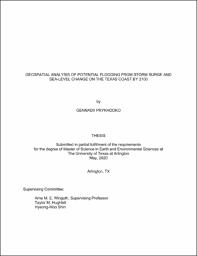
ATTENTION: The works hosted here are being migrated to a new repository that will consolidate resources, improve discoverability, and better show UTA's research impact on the global community. We will update authors as the migration progresses. Please see MavMatrix for more information.
Show simple item record
| dc.contributor.advisor | Winguth, Arne M. E. | |
| dc.creator | Prykhodko, Gennadii | |
| dc.date.accessioned | 2020-06-15T14:11:26Z | |
| dc.date.available | 2020-06-15T14:11:26Z | |
| dc.date.created | 2020-05 | |
| dc.date.issued | 2020-05-14 | |
| dc.date.submitted | May 2020 | |
| dc.identifier.uri | http://hdl.handle.net/10106/29133 | |
| dc.description.abstract | Tropical cyclones pose a major hazard to the State of Texas. Anthropogenic climate change and global warming have the potential to increase extreme weather events and lead to enhanced flood hazard zones. This study aims to analyze potential flooding from hurricane induced storm tides in the Houston metroplex area, and particularly in Harris County. A geospatial framework is proposed for modeling inundation from storm surge with sea-level rise. Spatial models and statistics are applied to the State of Texas with the focus on the Houston metropolitan area including Harris County. Historical and observational tropical cyclone data is used to examine past storm events and to construct spatial distribution models. Climatology of tropical cyclones reveals increasing rates of hurricanes Category 3 and higher in the Atlantic basin. Spatial modeling of local tropical cyclone frequency and intensity in combination with population exposure demonstrates that Harris County is at high risk for hurricane hazards. SLOSH model simulations of Category 5 hurricane storm surges show that under present day sea-level, a significant portion of Harris County is at risk of storm surge flooding. When combined with sea-level rise, magnitude and extent of flooding are amplified. Exposure of population, highway infrastructure and critical structures and facilities is investigated. Modeling of hurricane storm tide with projected sea-level rise scenarios shows that Harris County is extremely vulnerable to flooding under changing climate. The results suggest that a greater amount of this region’s infrastructure is projected to be exposed to damage from hurricane storm surge under sea-level rise scenarios. An expected increase in the frequency of intense hurricanes and sea-levels further exacerbates the vulnerability of this region. Under RCP 8.5, anthropogenic induced climate change is likely to substantially increase the vulnerability of people and infrastructure in greater Houston area to storm surge flooding by 2100. | |
| dc.format.mimetype | application/pdf | |
| dc.language.iso | en_US | |
| dc.subject | Storm surge | |
| dc.subject | GIS | |
| dc.subject | Spatial | |
| dc.subject | Modeling | |
| dc.subject | Sea-level | |
| dc.subject | SLR | |
| dc.subject | Climate change | |
| dc.subject | Tropical cyclone | |
| dc.subject | Hurricane | |
| dc.subject | HURDAT | |
| dc.subject | HURDAT2 | |
| dc.title | GEOSPATIAL ANALYSIS OF POTENTIAL FLOODING FROM STORM SURGE AND SEA-LEVEL CHANGE ON THE TEXAS COAST BY 2100 | |
| dc.type | Thesis | |
| dc.degree.department | Earth and Environmental Sciences | |
| dc.degree.name | Master of Science in Earth and Environmental Science | |
| dc.date.updated | 2020-06-15T14:11:26Z | |
| thesis.degree.department | Earth and Environmental Sciences | |
| thesis.degree.grantor | The University of Texas at Arlington | |
| thesis.degree.level | Masters | |
| thesis.degree.name | Master of Science in Earth and Environmental Science | |
| dc.type.material | text | |
| dc.creator.orcid | 0000-0001-5587-6331 | |
Files in this item
- Name:
- PRYKHODKO-THESIS-2020.pdf
- Size:
- 7.684Mb
- Format:
- PDF
This item appears in the following Collection(s)
Show simple item record


